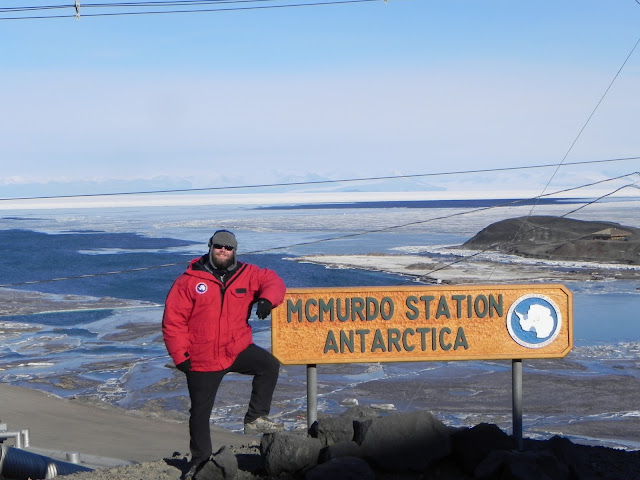 |
| A large wave passing the porthole near my workstation |
 |
| Our IT displaying the pressure record that bottomed out (on the right side of the page) |
Since I last wrote, we spent our 2 days of transit heading out to our first station only to be met by our first storm. This region of the world is especially treacherous in terms of weather since (a), it is near the point where constant cold meets more temperate air and the two mix rather turbulently, and (b) there is no land mass through the Southern Ocean, and wind is allowed to circle the globe continuously undeterred by land masses and spins up low pressure regions which then become storms that make their way right through our path. In the same manner, the ocean is allowed to flow continuously around the globe here and is therefore important to all of the worlds oceans and hence one of the reasons we are down here.
 |
| Pressure close up |
When the storm came, we resigned ourselves to take cover in the ice closer to the continent near Cape Adare (Western Ross Sea/ North West of McMurdo). The ice at least dampens the storm waves making it somewhat calmer. However, the winds were something fierce, blowing at a near constant 40 knots (46 mph) and full of snow and ice. When it was finally all over, I went out onto the decks and to my amusement, they were now covered with snow. It felt very strange seeing snow there on the ship. I knew I should expect it, but something about actually seeing it out on a ship goes against my intuition. First against the notion of snow over water; since snow cannot remain on the surface, it unconsciously came to be thought of a phenomena that occurs strictly on land, even though a ship is a suitable surface for snow to stick. Second, I think the majority of instances where one thinks of a ship voyage (at least myself), a warm sunny locale is imagined. Again, I expected the snow, only found it to be most amusing.
| The same deck covered in snow after a storm |
 |
| The deck outside my cabin before the storm |
After the first storm passed we began our stations over the shelf and slope off of Cape Adare in a north-easterly direction. Not long into it, came our second storm and halted progress again. This time the ship had no ice to hide in, so our only option was to turn into the wind and just ride out the storm while dodging wind blown ice bergs that can only be detected through the thick snow and fog by radar equipment. Luckily the ship handles very well in rough weather; we were in 20 foot seas (trough to crest), and the rocking motion seemed no worse than what I've experienced on smaller ships in smaller seas in the Gulf Of Mexico.
 |
| A cargo van dented from waves on the fantail (stern) |
Progress was still hard to manage due to the pitch and roll. Walking anywhere is of course hard, especially up the stairs and through the sets of fire doors found on each upper deck. I found for myself, that I don't get seasick, but I can sure understand why people do. I do however get headaches while trying to look at a computer screen, which certainly hindered or eliminated entirely my ability to do my own work or update the travelogue.
NOTE: Some of you may not know that I am also quite busy finishing up my Master's thesis while I am out here, which is what is meant by my own work.
 |
| A wave crashing over the bow during one of the storms with ice on window from spray. |
Before the second storm had even finished passing by, we were then hit by a third low pressure system, one even worse than the previous two. We were seeing continuous 50 knot winds (58 mph) with gusts up to 60 knots (69 mph) and the pressure plummeted down to about 935 mb which was so low that it went off of the bottom page of the old analog pressure recorder. It is surprising to see pressures this low that aren't hurricane force winds. Usually near the tropics, anything less than 1000 mb is at least a tropical storm.
The storms may sound a little scary, and they are a bit, especially in such a very cold region where there's little chance for rescue if anything goes wrong; yet I must confess, that I get kind of excited by the experience of such storms out in the polar ocean (sorry for you to have to hear that Mom). I very much enjoy going up to the bridge, feeling the rocking motion, and watching the large waves crash over the bow and splash high enough to splatter saltwater drops over the windows of the bridge 5 decks up from the main deck. I am unsure if it is the excitement of adventure, or if I actually enjoy a continuous multi-day roller coaster ride, but either way, I love it.


















































